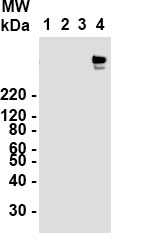Anti-Alpha-Spectrin, N-terminal [9.5.21] Antibody
This mouse IgG monoclonal antibody was generated against human red blood cell a-spectrin N terminal 1/3rd and is specific for human red blood cell a-spectrin N terminal 1/3rd of the protein.
Highlights:
- Reacts with human red blood cell a-spectrin N terminal 1/3rd of the protein
- Recommended for Western Blot applications
Spectrin is a cytoskeletal protein that lines the intracellular side of the plasma membrane in eukaryotic cells along with actin. Spectrin plays a role in cell shape control, arrangement of transmembrane proteins, and organelle positioning. Specifically, Alpha-spectrin is a tetramer and mutations in alpha-spectrin can result in a variety of hereditary red blood cell disorders (e.g. spherocytic hemolytic anemia including elliptocytosis type 2, pyropoikilocytosis).
From the laboratories of David W. Speicher, PhD, The Wistar Institute.
This mouse IgG monoclonal antibody was generated against human red blood cell a-spectrin N terminal 1/3rd and is specific for human red blood cell a-spectrin N terminal 1/3rd of the protein.
Highlights:
- Reacts with human red blood cell a-spectrin N terminal 1/3rd of the protein
- Recommended for Western Blot applications
Spectrin is a cytoskeletal protein that lines the intracellular side of the plasma membrane in eukaryotic cells along with actin. Spectrin plays a role in cell shape control, arrangement of transmembrane proteins, and organelle positioning. Specifically, Alpha-spectrin is a tetramer and mutations in alpha-spectrin can result in a variety of hereditary red blood cell disorders (e.g. spherocytic hemolytic anemia including elliptocytosis type 2, pyropoikilocytosis).
From the laboratories of David W. Speicher, PhD, The Wistar Institute.
| Product Type: | Antibody |
| Alternative Name(s): | Erythroid alpha-spectrin,Spectrin alpha chain, erythrocytic 1 |
| Antigen: | Human Red Blood Cell a-Spectrin N terminal 1/3rd of the protein |
| Accession ID: | P02549 |
| Molecular Weight: | 280 kDa |
| Isotype: | IgG |
| Clonality: | Monoclonal |
| Clone Name: | 9.5.21 |
| Reactivity: | Human |
| Immunogen: | Human Red Blood Cell a-Spectrin N terminal 1/3rd of the protein |
| Species Immunized: | Mouse |
| Purification Method: | Affinity Purified |
| Tested Applications: | Western Blot (1:250,000; 30sec exposure) |
| Storage: | -20C |
| Shipped: | Cold packs |
Western Blot

Lane 1, Human Melanoma (1205 LU); Lane 2, Human Ovarian Cancer (RMG1); Lane 3, Human Ovarian Cancer (OV90); Lane 4, Human Red Cell Membrane. Gel loads: Lanes 1-3, 25mg; Lane 4, 5mg. Antibody dilution: 1:250,000, 30sec exposure.
If you publish research with this product, please let us know so we can cite your paper.

![Anti-Alpha-Spectrin, N-terminal [9.5.21] Antibody Anti-Alpha-Spectrin, N-terminal [9.5.21] Antibody](https://www.kerafast.com/MediaStorage/Product/Images/Medium/1206_2001202001263812050.jpg)
